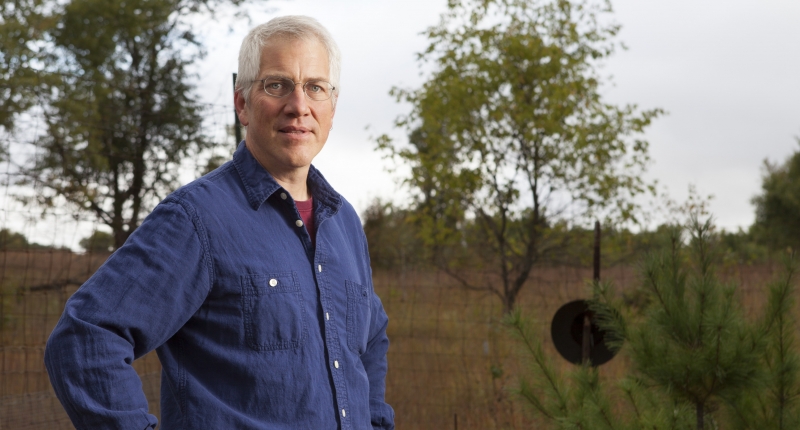NCEAS Portrait: Eric Seabloom Digs Up Nature's Common Threads from Ecology's Grassroots

Some ecologists seek out unique phenomena in nature like rare species, but Eric Seabloom searches for commonalities. As a co-founder of the Nutrient Network (NutNet), a grassroots collaboration of ecologists conducting the same experiment in over 100 research sites across the world, he is motivated by more than just the shared understandings this collective can generate.
Seabloom’s work with NutNet grew directly out of his involvement with NCEAS as a postdoc in the late 1990s. During a coffee break one day, Seabloom was discussing with fellow postdocs and working group members the challenges of getting a big-picture understanding of how grazing animals and nutrients, like nitrogen and phosphorus, impact grasslands across the globe. Many cups of coffee later, the group agreed the main problem they faced wasn’t a lack of experiments or data.
“Although [ecologists] were making great headway resolving long-term questions in ecosystem and community ecology, we kept running into challenges because every study used slightly different methods,” said Seabloom, who is now a professor of at the University of Minnesota and principal investigator for the Cedar Creek Long-Term Ecological Research (LTER) site.
Nonstandard methods lead to data that is difficult to combine and synthesize for larger analyses, and this wasn’t the only realization they made.
“We were complaining about scientists not using standard methods, and we quickly realized, rather guiltily, that we were those scientists,” said Seabloom.
NutNet became their solution, and it has since helped change the face of ecological synthesis science. The network functions as a distributed experiment allowing the synthesis of data and results, but without the limitations of trying to combine studies that were conducted in different ways. By standardizing and, thus, simplifying experimental design, NutNet also makes global-scale work accessible to ecologists who do not have access to lots of funding.
“We wanted to show that game-changing, global-scale science could be accomplished with a combination of compelling questions, creativity, and collaboration,” explained Seabloom, who continues to lead NutNet on its advisory team and to cross-pollinate ideas through synthesis working groups, such LTER's Biodiversity and Productivity team.
As the subject of this month’s NCEAS Portrait, Seabloom illustrates how the pursuit of commonalities can drive a career in ecology.
What was an “ah-ha” moment that changed the way you think about your work?
ES: I think one of the biggest insights for me was thinking about the nature of replications in experimental ecology. So many of our experiments are "replicated" in a single field at a single site. Demonstrating that something can happen at a single site is great first step – for example, showing that nutrient addition can lead to species extinctions or that diversity can increase productivity. However, for our field to progress, we need to move beyond this to test when and where the effects happen. Working at NCEAS really pushed me to search for truly general patterns that cut across ecosystems and taxonomic boundaries.
What about the future of NutNet makes you most excited?
ES: As NutNet data starts to stretch into their second decade, there will be new chances to integrate our spatially extensive experiment with concepts arising from the unique, long-term experiments at Long Term Ecological Research (LTER) sites. For example, LTER experiments have demonstrated how the effects of changes like global warming and nutrient addition play out over many years. With NutNet, we can now start asking what determines how long it will take for ecosystems to adjust to new conditions.
What impact do you hope your current LTER synthesis working group will have?
ES: Currently there is a disconnect between the scales at which we manipulate diversity in experiments (small plots) and the scales of biodiversity loss (regional and continental scales). The LTER synthesis working group I work with, “Scaling-up productivity responses to changes in biodiversity,” is allowing us to determine if the strong effects of biodiversity on ecosystems we detect in small, experimental plots are applicable at the larger scales that are more relevant for conservation. NutNet data are a core part of this work, because they provide the group with standardized experimental data taken at global scales.
What do you value most about scientific networks like LTER and NutNet?
ES: While the scientific impacts have been enormous, I feel like the biggest effects are probably social. Science is a social enterprise, and these long-term collaborations lead to our biggest jumps in understanding. For example, when our NutNet papers are submitted, they reflect the insight of dozens of ecologists with deep expertise in ecosystem, community, and theoretical ecology, and I think this depth has really increased their impacts.
What are you most passionate about in your research?
ES: I love the local natural history of my study sites. I get a lot of my ideas while I am out sampling my study sites in Oregon, California, and Minnesota. However, I also love finding general patterns that cut across many sites.
# # #
Caitlin Swalec is a 2018-2019 Science Communication Fellow and graduate student at UC Santa Barbara's Bren School of Environmental Science and Management.
NCEAS Portraits feature the people behind our work and impact.
